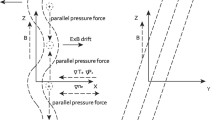Abstract
This study demonstrates the potential for shockwave–turbulent boundary layer interaction control in air using low current DC constricted surface discharges forced by moderate strength magnetic fields. An analytical model describing the physics of magnetic field forced discharge interaction with boundary layer flow is developed and compared to experiments. Experiments are conducted in a Mach 2.6 indraft air tunnel with discharge currents up to 300 mA and magnetic field strengths up to 5 Tesla. Separation- and non-separation-inducing shocks are generated with diamond-shaped shockwave generators located on the wall opposite to the surface electrodes, and flow properties are measured with schlieren imaging, static wall pressure probes and acetone flow visualization. The effect of plasma control on boundary layer separation depends on the direction of the Lorentz force (j × B). It is observed that by using a Lorentz force that pushes the discharge upstream, separation can be induced or further strengthened even with discharge currents as low as 30 mA in a 3-Tesla magnetic field. If shock-induced separation is present, it is observed that by using Lorentz force that pushes the discharge downstream, separation can be suppressed, but this required higher currents, greater than 80 mA. Acetone planar laser scattering is used to image the flow structure in the test section and the reduction in the size of recirculation bubble and its elimination are observed experimentally as a function of actuation current and magnetic field strength.

















Similar content being viewed by others
References
Bookey P, Wyckham C, Smits A (2005) Experimental investigations of Mach 3 shock-wave turbulent boundary layer interactions, AIAA 2005-4899. In: 35th AIAA fluid dynamics conference and exhibit, Toronto, 6–9 June
Chapman DR, Kuehn DM, Larson HK (1958) Investigation of separated flows in supersonic and subsonic streams with emphasis on the effect of transition. NACA Rept. 1356
Delery J, Marvin JG (1986) Shockwave boundary layer interactions, AGARD-AG-280
Dolling DS (2001) Fifty years of shock-wave/boundary-layer interaction research: what next? AIAA J 30(8):1517–1531
Fujino T, Funaki I, Mizuno M, Sugita H, Ishikawa M (2004) Numerical studies of influences of hall effect on MHD flow control around blunt body OREX. In: 35th AIAA plasmadynamics and lasers conference, Portland, 28 June–1 July, AIAA 2004-2561
Gaitonde DV (2008) High-speed magnetohydrodynamic flow control analyses with three-dimensional simulations. J Propuls Power 24:946
Jesse L, Nishihara M, Adamovich I, Samimy M (2009) High-lift airfoil trailing edge separation control using a single dielectric barrier discharge plasma actuator. Exp Fluids 0723-4864
Kalra CS, Shneider MN, Miles RB (2009) Numerical study of boundary layer separation control using magnetogasdynamic plasma actuators. Phys Fluids 21:106101. doi:10.1063/1.3233658
Kral L (1999, Spring) Active flow control technology. ASME Fluids Engineering Division Newsletter, pp 3–6
Lin JC (2002) Review of research on low-profile vortex generators to control boundary layer separation. Prog Aerosp Sci 38:389–420
Lineberry JT, Bityurin VA, Bocharov AN (2002) Analytical study of MHD flow interaction around a right circular cylinder in transverse hypersonic flow. In: 33rd Plasmadynamics and lasers conference, Maui, 20–23 May, AIAA-2002-2112
McCormick DC (1992) Shock-boundary layer interaction control with low-profile vortex generator s and passive cavity. In: AIAA Paper 92-0064, 30th AIAA Aerospace Sciences Meeting and Exhibit, Reno, January 6–9
Nishihara M, Jiang N, Rich JW, Lempert WR, Adamovich IV (2005) Low-temperature supersonic boundary layer control using repetitively pulsed magnetohydrodynamic forcing. Phys Fluids 17:106102
Opaits DF, Neretti G, Likhanskii AV, Zaidi S, Shneider MN, Miles RB, Macheret SO (2007) Experimental investigation of DBD plasma actuators driven by repetitive high voltage nanosecond pulses with DC or low frequency sinusoidal bias. In: 38th Plasma dynamics and lasers conference, Miami, 25–28 June, AIAA Paper No. 2007-4532
Raizer YP (1997) Gas discharge physics. Springer, Berlin
Shang JS, Kimmel R, Hayes J, Tyler C, Menart J (2005) Hypersonic experimental facility for magnetoaerodynamic interactions. J Spacecr Rockets 42(5), September–October
Wu M, Bookey P, Martin MP, Smits AJ (2005) Analysis of shockwave/turbulent boundary layer interaction using DNS and experimental data. In: 43rd AIAA aerospace sciences meeting and exhibit, Reno, 10–13 January, AIAA Paper No. 2005-0310
Acknowledgments
This work was supported by the AFOSR Unsteady Aerodynamics and Hypersonic Program, by a DARPA STTR program with CMI Inc., and by an AFOSR SBIR program (also with CMI. Inc.).
Author information
Authors and Affiliations
Corresponding author
Rights and permissions
About this article
Cite this article
Kalra, C.S., Zaidi, S.H., Miles, R.B. et al. Shockwave–turbulent boundary layer interaction control using magnetically driven surface discharges. Exp Fluids 50, 547–559 (2011). https://doi.org/10.1007/s00348-010-0898-9
Received:
Revised:
Accepted:
Published:
Issue Date:
DOI: https://doi.org/10.1007/s00348-010-0898-9




